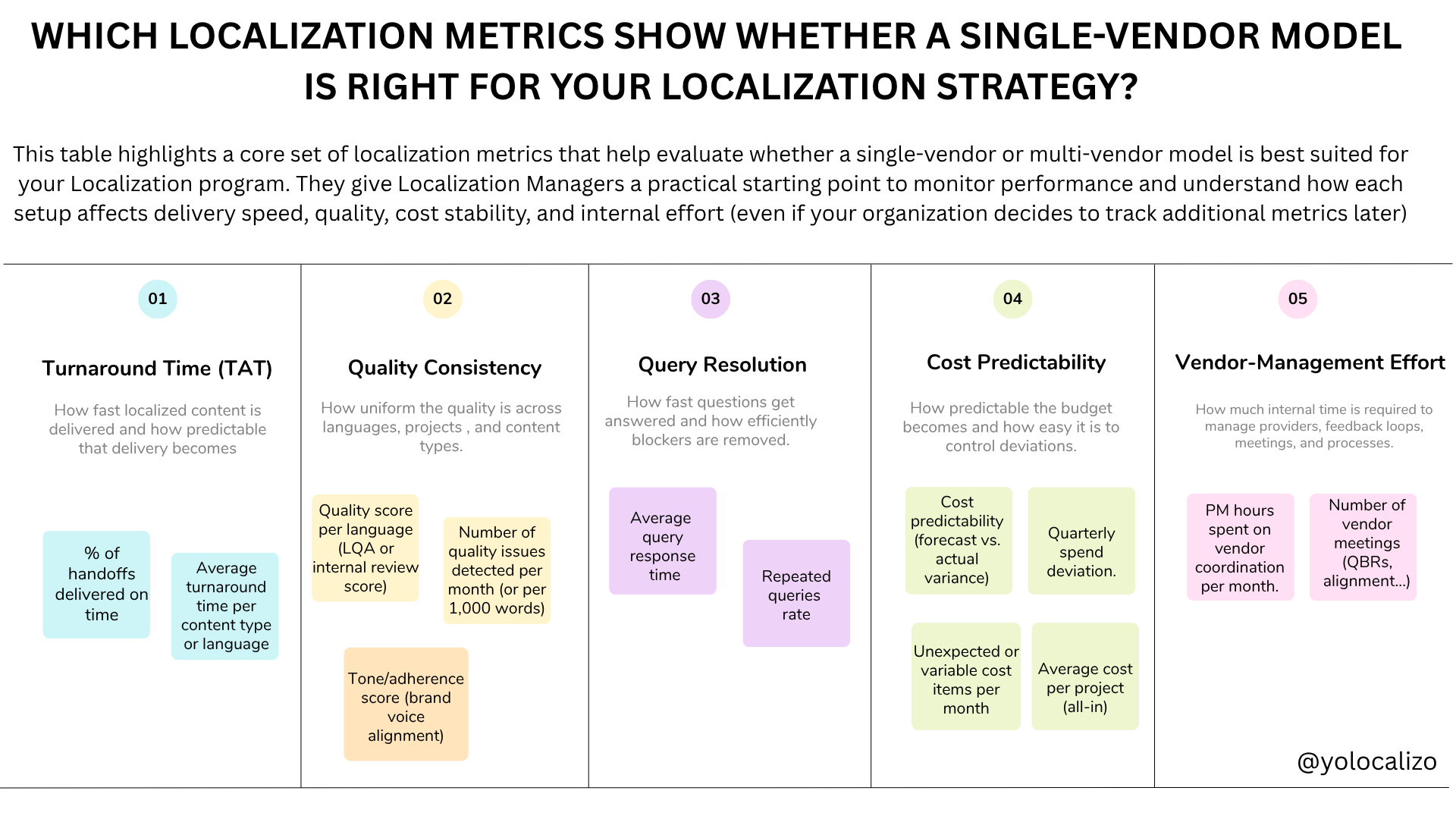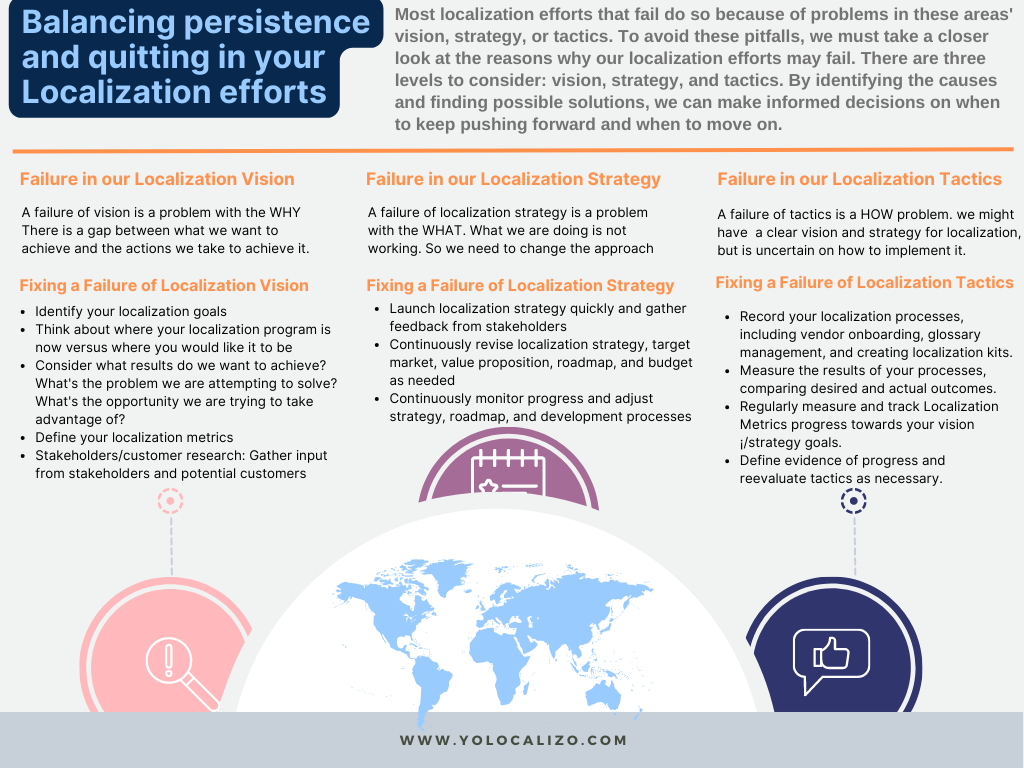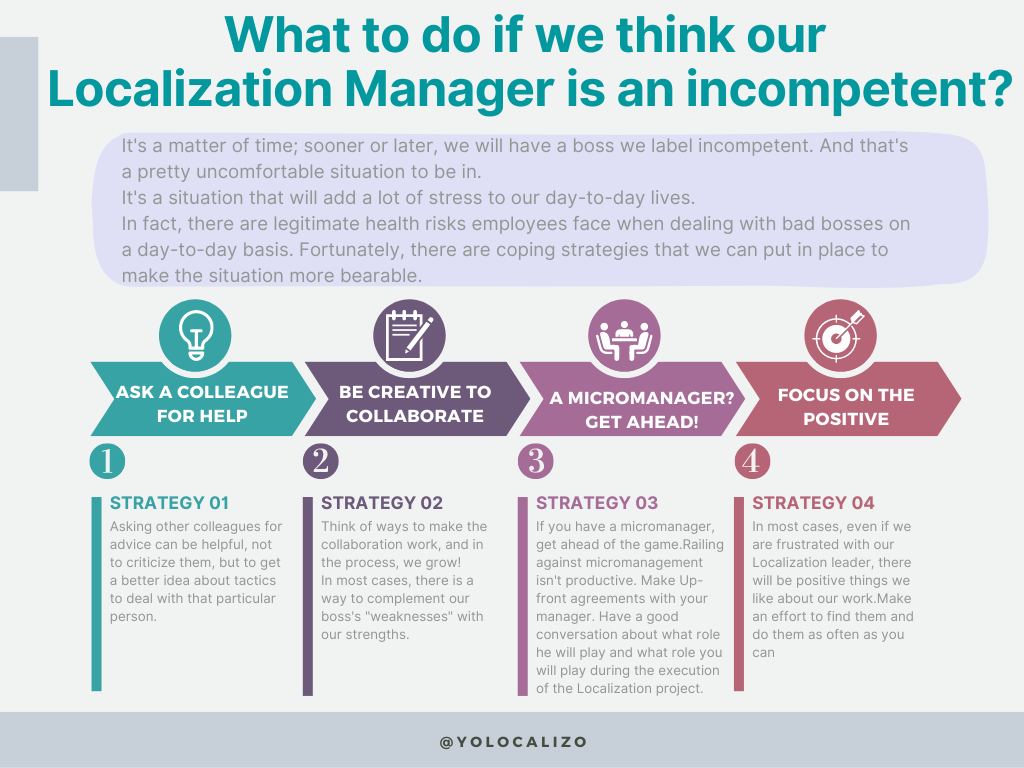Balancing persistence and quitting in your Localization efforts
On occasion, customers and companies may not prioritize excellence in localization; they may only seek translated content that is cheap and fast. Quality becomes secondary in this scenario. For these customers and companies, localization is a commodity, not a differentiating factor. Similar to how there are shops in my neighborhood that sell a loaf of bread for 50 cents and others that sell it for 2 Euros, the same concept applies to localization. The quality may be the same, but the prices can vary significantly.
Selling 2 Euro bread to someone who is happy with 50 cent bread can be challenging and frustrating for the seller if they persist in that approach. Despite the quality being better, the efforts and strategies the bakery employs to sell their bread may not be effective. Is it worth continuing to insist and never give up?
In the world of localization, we can see parallels with the bread example. There are companies that offer localization services at a low cost per word, and others that charge significantly higher prices. Just as there is cheap and expensive bread, there is also cheap and expensive localization.
It may be difficult to convince stakeholders who do not see the added value of a localization program. Is it worth continuing to insist on rolling out these programs in these cases?
As localization industry professionals, we are all familiar with terms like grit, resilience, and persistence. We understand the importance of not giving up easily when working to give visibility to the value that a good localized product can bring. However, blindly following the advice to never give up can be a mistake. Successful individuals and companies know when to cut their losses and move on.
Take the example of Microsoft and its Windows Phone. Despite investing a significant amount of money and assigning capable people, they were unable to keep up with the popularity of iPhones and Android phones. Microsoft did not give up on the first try, but eventually realized that continuing to invest resources, efforts, and money into the project was not a wise decision in the long run.
The key is to know when to keep pushing forward and when to let go. We need to ask ourselves: how do we determine when it's time to move on and when to keep trying? Author James Clear, known for his best-seller Atomic Habits, suggests that most initiatives fail due to a failure in vision, strategy, or tactics. In my experience in the localization industry, this holds true. Most localization efforts that fail do so because of problems in these areas.
To avoid these pitfalls, we must take a closer look at the reasons why our localization efforts may fail. There are three levels to consider: vision, strategy, and tactics. By identifying the causes and finding possible solutions, we can make informed decisions on when to keep pushing forward and when to move on.
Click HERE to download the image
Failure in our Localization Vision
When our localization vision fails, it usually happens because there is a gap between what we want to achieve and the actions we take to achieve it. The best way to explain this is by using an analogy. For example, if I want a strong and healthy abdomen but eat carrot cake, Nutella croissants, and sweets more often than I should, my vision (being fit) is not aligned with my actions (eating sweets). By the way, this happens to me very often haha
Let's look at this applied to the world of localization. We have a vision that the localization program we are executing should not be an afterthought but an activity that we already pay attention to in the conceptualization phase of software development. However, if in our day-to-day, we just translate the localization requests that arrive in our inbox or JIRA board, we will have an alignment problem. My vision (localization is not an afterthought) is not aligned with my actions (waiting for tickets and localizing them).
A failure of vision is a problem with the WHY.
The "why" is not aligned with the actions. If my vision is that localization activity should not be an afterthought, the actions to be performed must go far beyond localizing the content that needs to be localized. This is taken for granted. Actions should be directed to explain, for example, the value of our localization program and how it contributes to our company's global growth. Actions should also be directed to explain how internationalizing the software from the design phase will help to have fewer bugs later on.
Additionally, actions should be directed to define and implement best practices in creating inclusive content. We must consider many actions so that our vision of localization, not being an afterthought, is realized. Localizing everything that comes in will not be enough to deliver the vision that localization is not an afterthought. The "why" would not be aligned with the actions, and that would lead to a failure of vision.
Fixing a Failure of Vision
There are several ideas we can consider to fix a failure of localization vision:
Identify your localization goals: Take time to think about your localization goals, as this will lead you to create the vision of your localization program more effectively. For example, what do you hope to achieve through localization? Some potential goals might include increasing the global reach of your products or services, improving the customer experience for users in different countries or languages, or expanding into new markets.
Where are you now, and where do you want to be? Think about where your localization program is now versus where you would like it to be. Processes such as Gap analysis or SWOT can help you in this reflection phase.
For "Where do you want to be," it can be helpful to think about the following:
· What results do we want to achieve?
· What's the problem we are attempting to solve?
· What's the opportunity we are trying to take advantage of?
Define your localization metrics: Set specific metrics for the digital product you plan to localize. These metrics should align with the overall business strategy and be based on the needs of your target market.
Stakeholders/customer research: Gather input from your stakeholders and potential customers to understand their needs, pain points, and preferences. This can help shape the localization vision and ensure that it is relevant and valuable to the target market and the company.
Failure in our Localization Strategy
A failure of localization strategy is a problem with the WHAT. What we are doing is not working. This can happen for multiple reasons.
For example:
If your localization strategy is not helping to generate the desired level of revenue or profitability, it could be a sign that the localization strategy is not effectively helping to monetize the product or target the right customers.
Difficulty executing the product roadmap: If you are having trouble making progress on the product roadmap, it could be a sign that the Localization strategy is not clear enough or is not aligned with business objectives.
Lack of alignment with company strategy: If the Localization strategy is not aligned with the overall company strategy, it could lead to conflicting priorities and a lack of focus.
How to solve a Localization strategy problem
Put it in place quickly and get repeated feedback. Generally speaking, it is not a good idea to wait until we have what we think is the perfect localization strategy to start our localization efforts. It is much better to launch our localization strategy quickly and then engage with stakeholders to get their feedback. This can include customers, partners, and team members. Use their input to refine the localization strategy.
Revise the product localization strategy. This may involve reassessing the target market, redefining the value proposition of the localization strategy, or adjusting the localization roadmap and budget.
Periodically review progress and make adjustments as necessary. Continually monitor product progress and make necessary adjustments to the strategy, roadmap, or development processes.
Failure in our Localization Tactics
A failure of tactics is a HOW problem. You may have a compelling vision and a clear idea of the elements of your localization strategy, but you are unclear on how to execute the strategy and vision. If we continue with our previous example, we have a vision that Localization is not an afterthought, and we have a strategy defined for it. For instance, we have elements in our Localization strategy such as:
Target languages and regions: the languages and regions on which the localization effort will be focused.
Localization scope: The types of content to be localized, such as user interfaces, documentation, marketing materials, etc.
But you may not know how to do this. You may not know how to do market sizing to identify the target languages and markets that present the most significant opportunities to contribute to your global expansion. Or you may not know how to do a localization scope analysis to determine what content you should use professional translators for vs. what content you should rely on machine translation for. A tactics failure is often related to not knowing how to execute tasks
How to fix a Localization tactics failure
Record your localization processes. A fundamental part of improving the execution of your tactics is to document your localization processes. If we have defined tactics problems as a problem in the HOW. The best way to minimize these problems will inevitably be to record your localization processes. Have checklists on how to do vendor onboarding, have processes on how you are going to do glossary management, create templates on what should be included in a Localization kit, document, document, and document. Make checklists, mind maps, templates, choose the format that works best for you, but take the time to record your Localization process.
Measure your results. If you really want to improve your localization tactics, you must constantly measure the results of your processes. Compare the desired results with the actual results. If something is important to us, we must first get used to measuring it and then compare what we get with what we would like to get. After all, if we don't measure and compare, how will we know what tactics are working?
By measuring outcomes regularly and keeping track of them, we will know if we are progressing correctly towards our objectives or not.
It is fundamental to define what evidence will prove we are making progress, and we need to reevaluate our tactics when necessary.
Summarizing
It is difficult to know when to give up versus when to keep trying, but thinking about whether we have a failure in our Localization vision, our Localization strategy, or our Localization tactics can be very helpful in determining what we should do.
Hopefully, the framework explained in this post will help you navigate the difficult decision of deciding when to quit and when to stick with it.













This feels like a pivotal moment. Localization teams are being asked to support more markets, move faster, use AI responsibly, and show impact, not just output. Expectations are higher than ever, but many teams are still trained mainly for execution. We are strong at delivering localization work, yet we often struggle to move from output to outcome and to clearly explain the impact of what we do.